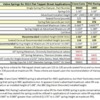Crower #15388 is similar to the Windsor cam above, but it is for the 351C.
About 61° overlap, 112° LSA.
The advertised lift is 0.524/0.533
The "net" lift is 0.502/0.509
Obviously we can do better in terms of valve lift if we do a custom cam.
The best Crane cam I found was #521131, the valve lift was better. It had about 60° overlap, but 108° LSA. The exhaust valve opened too late, the intake valve closed too early. Altering the cam timing to improve one aspect only makes the other worse.
The cam grinders are capable of producing better work, but the marketplace, magazines, SEMA, don't demand it from them. Their bottom line is to manufacture and market what sells, and what is competitive with the other cam grinders.


